Metallographic Specimen Preparation
Effective metallographic specimen preparation is essential for accurate microstructure analysis, defect detection, and reliable hardness testing. It preserves the true structure of the material, enabling clear, high-quality imaging and consistent, reproducible results. Well-prepared samples reveal critical features like grain boundaries, inclusions, cracks, and heat treatment effects—supporting quality control, failure analysis, and research. By following standardised preparation methods, labs can improve efficiency, reduce errors, and ensure comparability across samples, making it a vital step in both industrial and scientific applications.
PLEASE NOTE: ETCHING REAGENTS CURRENTLY NOT AVAILABLE FROM KEMET
Disclaimer: Specimen preparation techniques are for guidance purposes only. Kemet recommend these should be tested on non-critical samples first and offer free trials to help establish the optimum process using Kemet equipment and consumables.
Material: Gray Cast Iron
Results: The graphite flakes are uniformly distributed in the pearlitic matrix (A type graphite). Overetching should be avoided in order to prevent graphite pull-outs. The below given preparation method gives perfect results.
Etching: 2% Nital
Cutting: TRENO-H Aluminium Oxide cut off wheel.
Mounting: Ecopress 102 Automatic Mounting Press with Black Phenolic Resin
Mechanical Preparation: FORCIPOL 102 Grinding / Polishing Machine + FORCIMAT Automatic Specimen Mover.
| Parameter / Stage | Surface | Abrasive | Lubricant | Force per Sample, (N) | Time min. | Disc Speed, rpm | Relative Rotation |
|---|---|---|---|---|---|---|---|
| Planar Grinding | Met Disc Paper | 180 Grit SiC | Water | 25 | 2 min. or until plane | 300 | Contra |
| Bramet Disc Paper | |||||||
| Fine Grinding. | Met Disc Paper | 400 Grit SiC | Water | 25 | 2 | 300 | Contra |
| Bramet Disc Paper | |||||||
| Fine Grinding. | Met Disc Paper | 800 Grit SiC | Water | 25 | 2 | 300 | Contra |
| Bramet Disc Paper | |||||||
| Fine Grinding. | Met Disc Paper | 1200 Grit SiC | Water | 20 | 2 | 250 | Contra |
| Bramet Disc Paper | |||||||
| Final Polishing | MRE Polishing Pad | Alpha Alumina. 1µ Powder | Water | 15 | 4 | 150 | Comp. |
Magnification: 550X (Brightfield)
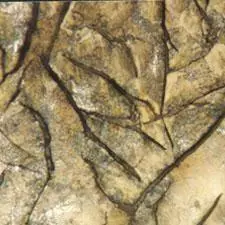
Material: Historical China (ceramic)
Results: The microstructure of an Iznik (Nicea) china from 15th century. In polished surface, the coated and pointed zone are clearly seen. The dispersion of benthonid bonded quarsit grains is homogeneous. Low cutting force with low feed is recommended.
Cutting: MICRACUT 202 Precision Cut-off machine with ø200mm Kemet Diamond cut-off wheels
Mounting: Cold Mounting and Embedding Form
Mechanical Preparation: FORCIPOL 202 Grinding / Polishing Machine +FORCIMAT Automatic Specimen Mover.
| Parameter / Stage | Surface | Abrasive | Lubricant | Force per Sample, (N) | Time min. | Disc Speed, rpm | Relative Rotation |
|---|---|---|---|---|---|---|---|
| Planar Grinding | Met Disc Paper | 180 Grit SiC | Water | 30 | 2 min. or until plane | 300 | Contra |
| Bramet Disc Paper | |||||||
| Fine Grinding. | Met Disc Paper | 400 Grit SiC | Water | 30 | 2 | 300 | Contra |
| Bramet Disc Paper | |||||||
| Met Disc Paper | 600 Grit SiC | Water | 25 | 2 | 300 | Contra | |
| Bramet Disc Paper | |||||||
| Met Disc Paper | 800 Grit SiC | Water | 25 | 2 | 300 | Contra | |
| Bramet Disc Paper | |||||||
| Met Disc Paper | 1200 Grit SiC | Water | 20 | 2 | 250 | Contra | |
| Bramet Disc Paper | |||||||
| Final Polishing | PSU-M Polishing Pad | 0.25µ Aquapol-P Diamond Suspension | GW2 | 15 | 4 | 150 | Contra |
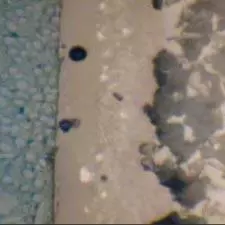
Material: 50 CrV4 Low alloy steel
Results: The existence of alloy carbides is due ro 1.1% chromium. Very thin carbide particles can be seen in the tempered martensitic matrix in the microstructure. Below given preparation method gives very good scratchfree surface.
Etching: 3% Nital
Cutting: TRENO-M cut off wheel.
Mounting: Ecopress 102 Automatic Mounting Press with Hard Epoxy resin
Mechanical Preparation: FORCIPOL 202 Grinding / Polishing Machine + FORCIMAT Automatic Specimen Mover.
| Parameter / Stage | Surface | Abrasive | Lubricant | Force per Sample, (N) | Time min. | Disc Speed, rpm | Relative Rotation |
|---|---|---|---|---|---|---|---|
| Planar Grinding | Met Disc Paper | 180 Grit SiC | Water | 30 | 2 min. or until plane | 300 | Contra |
| Bramet Disc Paper | |||||||
| Fine Grinding. | Met Disc Paper | 400 Grit SiC | Water | 30 | 2 | 300 | Contra |
| Bramet Disc Paper | |||||||
| Fine Grinding. | Met Disc Paper | 800 Grit SiC | Water | 30 | 2 | 300 | Contra |
| Bramet Disc Paper | |||||||
| Pre Polishing | MRE Polishing Pad | 6µ Aquapol-P Diamond Suspension | Blue | 25 | 3 | 200 | Contra |
| Final Polishing | MBL Polishing Pad | 1µ Aquapol-P Diamond Suspension | Blue | 20 | 4 | 150 | Contra |
Magnification: 300X
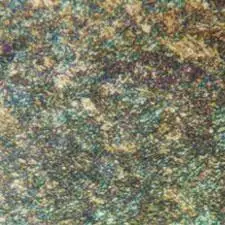
Material: Mg-9Al (Magnesium Alloy)
Results: In this cast structure, the segregation can easily be seen. Eutectic area (dark) are located in grain boundaries.
Etching: 40ml ethanol + 10ml HNO3
Cutting: TRENO-NF cut off wheel.
Mounting: Ecopress 102 Automatic Mounting Press with Black Phenolic Powder.
Mechanical Preparation: FORCIPOL 102 grinding and polishing system.
| Parameter / Stage | Surface | Abrasive | Lubricant | Force per Sample, (N) | Time min. | Disc Speed, rpm | Relative Rotation |
|---|---|---|---|---|---|---|---|
| Planar Grinding | Diamond Grinding Disc | 220 Grit | Water | 25 | Until Plain | 250 | Contra |
| Grinding | Diamond Grinding Disc | 600 Grit | Water | 25 | 2 | 250 | Contra |
| Fine Grinding | Diamond Grinding Disc | 1200 Grit | Water | 25 | 1 | 300 | Contra |
| Pre Polishing | Fine Grinding disc Green | 3µ Aquapol-P Diamond Suspension | Blue | 15 | 4 | 150 | Contra |
| Final Polishing | CHEM-H Polishing Pad | COL-K (NC) | Blue | 20 | 2 | 150 | Contra |
Magnification: 90X (Brightfield)
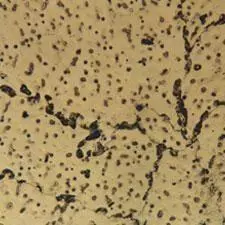
Material: Nodular Cast Iron, Ferritic + Pearlitic
Results: This type of cast iron has more toughness. Ferrite zones (violet) and perlite surround the nodular graphites. Polarized light illumination is recommended to analyze the graphites.
Etching: 2% Nital
Cutting: TRENO-H Aluminium Oxide cut off wheel.
Mounting: Ecopress 102 Automatic Mounting Press with Black Phenolic Hot Mounting resin
Mechanical Preparation: FORCIPOL 102 grinding and polishing system.
| Parameter / Stage | Surface | Abrasive | Lubricant | Force per Sample, (N) | Time min. | Disc Speed, rpm | Relative Rotation |
|---|---|---|---|---|---|---|---|
| Planar Grinding | Diamond Grinding Disc | 220 Grit | Water | 25 | Until Plain | 250 | Contra |
| Grinding | Diamond Grinding Disc | 600 Grit | Water | 25 | 2 | 250 | Contra |
| Fine Grinding | Diamond Grinding Disc | 1200 Grit | Water | 25 | 1 | 300 | Contra |
| Pre Polishing. | Fine Grinding disc Green | 3µ Aquapol-M Diamond Suspension | Blue | 15 | 4 | 150 | Contra |
| Final Polishing | MBLPolishing Pad | 1µ Aquapol-M Diamond Suspension | Blue | 15 | 1 | 150 | Contra |
Magnification: 400X (Polarized Iight)
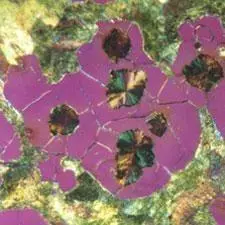
Material: Nodular Cast Iron, Pearlitic
Results: Nodular Cast Iron is a commonly used engineering material. Strength and ductility is very good combined. Matrix is completely pearlitic and ferrite surrounds the graphite nodules.
Etching: 2% Nital
Cutting: TRENO-H Aluminium Oxide cut off wheel.
Mounting: Ecopress 102 Automatic Mounting Press with Black Phenolic Hot mounting resin
Mechanical Preparation: FORCIPOL 102 grinding and polishing system.
| Parameter / Stage | Surface | Abrasive | Lubricant | Force per Sample, (N) | Time min. | Disc Speed, rpm | Relative Rotation |
|---|---|---|---|---|---|---|---|
| Planar Grinding | Diamond Grinding Disc | 220 Grit | Water | 25 | 1 | 250 | Contra |
| Grinding | Diamond Grinding Disc | 600 Grit | Water | 25 | 2 | 250 | Contra |
| Fine Grinding | Diamond Grinding Disc | 1200 Grit | Water | 25 | 1 | 300 | Contra |
| Pre Polishing. | Fine Grinding disc Green | 3µ Aquapol-M Diamond Suspension | Blue | 15 | 4 | 150 | Contra |
| Final Polishing | MBL Polishing Pad | 1µ Aquapol-M Diamond Suspension | Blue | 15 | 1 | 150 | Contra |
Magnification: 200X (Polarized light)
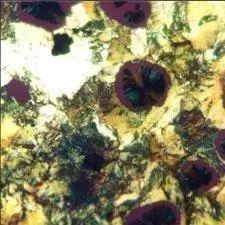
Material: Steel, Pearlitic
Results: Pearlitic steels are usually quenched and tempered. Microstructure is completely pearlitic. In high magnifications pearlitic constituents are observed.
Etching: 3% Nital
Cutting: TRENO-M cut off wheel.
Mounting: Ecopress 102 Automatic Mounting Press with Epoxy, Hard
Mechanical Preparation: Forcipol 102 grinding and polishing system.
| Parameter / Stage | Surface | Abrasive | Lubricant | Force per Sample, (N) | Time min. | Disc Speed, rpm | Relative Rotation |
|---|---|---|---|---|---|---|---|
| Planar Grinding | Diamond Grinding Disc | 220 Grit | Water | 25 | 1 | 250 | Contra |
| Grinding | Diamond Grinding Disc | 600 Grit | Water | 25 | 2 | 250 | Contra |
| Fine Grinding | Diamond Grinding Disc | 1200 Grit | Water | 25 | 1 | 300 | Contra |
| Pre Polishing | Fine Grinding disc Green | 3µ Aquapol-P Diamond Suspension | Blue | 15 | 4 | 150 | Contra |
| Final Polishing | MBL Polishing Pad | 1µ Aquapol-P Diamond Suspension | Blue | 15 | 1 | 150 | Contra |
Magnification: 1600X
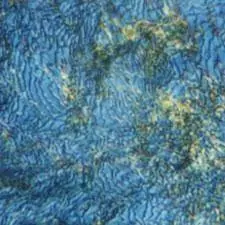
Material: Commercial Pure Copper
Results: Since it is a soft material, it is recommended to use short times during mechanical preparation. By using polarized light, the oxide inclusions are easily visible. Twins are typical in annealed microstructure.
Etching: 50ml H2O + 50ml ammonia + 1-2 drops H2O2
Cutting: TRENO-NF cut off wheel.
Mounting: Ecopress 102 Automatic Mounting Press with Black Phenolic Hot Mounting Resin
Mechanical Preparation: FORCIPOL 102 Grinding / Polishing Machine + FORCIMAT Automatic Specimen Mover.
| Parameter / Stage | Surface | Abrasive | Lubricant | Force per Sample, (N) | Time min. | Disc Speed, rpm | Relative Rotation |
|---|---|---|---|---|---|---|---|
| Planar Grinding | Met Disc Paper | 180 Grit SiC | Water | 30 | 2 min. or until plane | 300 | Contra |
| Bramet Disc Paper | |||||||
| Fine Grinding. | Met Disc Paper | 400 Grit SiC | Water | 25 | 2 | 300 | Contra |
| Bramet Disc Paper | |||||||
| Fine Grinding. | Met Disc Paper | 800 Grit SiC | Water | 25 | 2 | 300 | Contra |
| Bramet Disc Paper | |||||||
| Fine Grinding. | Met Disc Paper | 1200 Grit SiC | Water | 25 | 2 | 300 | Contra |
| Bramet Disc Paper | |||||||
| Pre Polishing. | MBL Polishing Pad | 1µ Aquapol-P Diamond Suspension | Blue | 15 | 4 | 150 | Comp. |
| Final Polishing | CHEM-H Polishing Pad | COL-K NC | Water | 15 | 2 | 150 | Comp. |
Magnification: 180X (Brightfield)
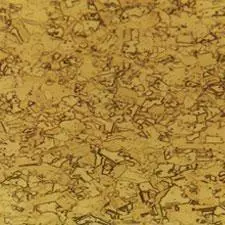
Material: Commercial Pure Titanium
Results: Microstructure consists of grains having equal axis. Since the material is soft, low sample forces should be applied during mechanical preparations.
Etching: Kroll solution (10 ml HF + 30 ml HNO3 + 50 ml H2O)
Cutting: TRENO-NF cut off wheel.
Mounting: Ecopress 102 Automatic Mounting Press with Black Phenolic Powder.
Mechanical Preparation: FORCIPOL 102 grinding and polishing system.
| Parameter / Stage | Surface | Abrasive | Lubricant | Force per Sample, (N) | Time min. | Disc Speed, rpm | Relative Rotation |
|---|---|---|---|---|---|---|---|
| Planar Grinding | Diamond Grinding Disc | 220 Grit | Water | 25 | Until Plain | 250 | Contra |
| Grinding | Diamond Grinding Disc | 600 Grit | Water | 25 | 2 | 250 | Contra |
| Fine Grinding | Diamond Grinding Disc | 1200 Grit | Water | 25 | 1 | 300 | Contra |
| Pre Polishing | Fine Grinding disc Green | 6µ Aquapol-P Diamond Suspension | Blue | 15 | 4 | 150 | Contra |
| Final Polishing | CHEM-H | COL-K NC | Water | 20 | 2 | 150 | Contra |
Alternative Process
Cutting: TRENO-NF Silicon Carbide cut-off wheel.
Mounting: Ecopress 102 Automatic Mounting Press with Black Phenolic Powder.
Mechanical Preparation: Forcipol 102 grinding and polishing system.
| Parameter / Stage | Surface | Abrasive | Lubricant | Force per Sample, (N) | Time min. | Disc Speed, rpm | Relative Rotation |
|---|---|---|---|---|---|---|---|
| Planar Grinding | Diamond Grinding Disc | 220 Grit | Water | 20 | Until Plain | 100 | Contra |
| Pre Polishing | MST | 9µ Aquapol-P Diamond Suspension | Blue | 25 | 4 | 300 | Contra |
| Final Polishing | CHEM-H | COL-K NC | Water | 20 | 4 | 150 | Contra |
or
| Parameter / Stage | Surface | Abrasive | Lubricant | Force per Sample, (N) | Time min. | Disc Speed, rpm | Relative Rotation |
|---|---|---|---|---|---|---|---|
| Planar Grinding | Bramet N | 320 Grit | Water | 25 | 4 | 250 | Comp |
| Pre Polishing | MST | 9µ Aquapol-P Diamond Suspension | Blue | 40 | 5.5 | 250 | Contra |
| Final Polishing | CHEM-H | COL-K NC | Water | 40 | 5 | 250 | Contra |
Magnification: 270X (Brightfield)
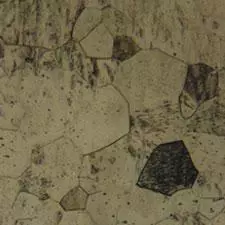
Material: Rubber Joint
Results: The rubber joint is moulded for precise measuring. The details of the cross-section can be examined in details.
Cutting: Kemet Diamond Cut off wheel.
Mounting: Cold Mounting and Embedding Form
Mechanical Preparation: FORCIPOL 202 Grinding / Polishing Machine + FORCIMAT Automatic Specimen Mover.
| Parameter / Stage | Surface | Abrasive | Lubricant | Force per Sample, (N) | Time min. | Disc Speed, rpm | Relative Rotation |
|---|---|---|---|---|---|---|---|
| Planar Grinding | Met Disc Paper | 180 Grit Sic | Water | 20 | 2 min. or until plane | 300 | Contra |
| Bramet Disc Paper | |||||||
| Fine Grinding. | Met Disc Paper | 400 Grit Sic | Water | 25 | 2 | 250 | Contra |
| Bramet Disc Paper | |||||||
| Met Disc Paper | 800 Grit Sic | Water | 25 | 2 | 250 | Contra | |
| Bramet Disc Paper | |||||||
| Final Polishing | ASF/MSF Polishing Pad | 6μ Aquapol-M Diamond Suspension | GW2 | 20 | 3 | 150 | Contra |
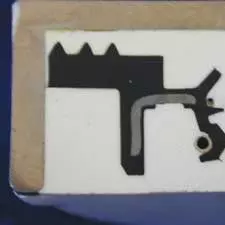
Material: Silicon Nitride (Ceramic)
Mounting: Ecopress 102 with epoxy resin
Mechanical Preparation: FORCIPOL 202 Grinding / Polishing Machine + FORCIMAT 102 Automatic Specimen Mover.
| Parameter / Stage | Surface | Abrasive | Lubricant | Force per Sample, (N) | Time min. | Disc Speed, rpm | Relative Rotation |
|---|---|---|---|---|---|---|---|
| Planar Grinding | Diamond Grinding Disc | 76 Micron | Water | 30 | Until plane | 300 | Comp |
| Integrity stage | AST Polishing Pad | 9 Micron WX diamond suspension | 30 | 10 | 150 | Comp | |
| Polishing | ASFL Polishing Pad | 3 Micron WX diamond suspension | 30 | 10 | 150 | Comp | |
| Final Polishing | Chem-H Polishing Pad | Col-K R | 30 | 5 | 100 | Contra |
![]()
Material: Steel, case hardenable
Results: Equilibrium phases of carburizing region are seen obviously from surface towards inner areas. Carburizing region is thicker than 2 mm. Below given perparation method gives ideal results.
Etching: 2% Nital
Cutting: TRENO-S Aluminium Oxide cut off wheel.
Mounting: Ecopress 102 Automatic Mounting Press with Epoxy, Hard, or Black Phenolic resin.
Mechanical Preparation: FORCIPOL 102 Grinding / Polishing Machine + FORCIMAT Automatic Specimen Mover.
| Parameter / Stage | Surface | Abrasive | Lubricant | Force per Sample, (N) | Time min. | Disc Speed, rpm | Relative Rotation |
|---|---|---|---|---|---|---|---|
| Planar Grinding | Met Disc Paper | 180 Grit SiC | Water | 30 | 2 min. oruntil plane | 300 | Contra |
| Bramet Disc Paper | |||||||
| Fine Grinding. | Met Disc Paper | 400 Grit SiC | Water | 30 | 2 | 300 | Contra |
| Bramet Disc Paper | |||||||
| Fine Grinding. | Met Disc Paper | 800 Grit SiC | Water | 30 | 2 | 300 | Contra |
| Bramet Disc Paper | |||||||
| Pre Polishing | MRE Polishing Pad | 6µ Aquapol-P Diamond Suspension | Blue | 25 | 3 | 200 | Contra |
| Final Polishing | MBL Polishing Pad | 1µ Aquapol-P Diamond Suspension | Blue | 20 | 3 | 150 | Contra |
Magnification: 25X (Brightfield)
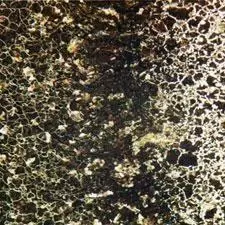
Material: TiC Coating
Results: Single layer titanium carbide coating deposited on pearlitic low alloy steel through a thermochemical process. The thickness is approx. 10 microns and hardness is arround 2500 kg/mm². Careful low feed cutting recommended. Edge effects should be avoided.
Etching: 3% Nital
Cutting: TRENO-M cut off wheel.
Mounting: Ecopress 102 Automatic Mounting Press with Black Epoxy resin
Mechanical Preparation: Forcipol 102 grinding and polishing system.
| Parameter / Stage | Surface | Abrasive | Lubricant | Force per Sample, (N) | Time min. | Disc Speed, rpm | Relative Rotation |
|---|---|---|---|---|---|---|---|
| Planar Grinding | Diamond Grinding Disc | 220 Grit | Water | 25 | Until Plain | 250 | Contra |
| Grinding | Diamond Grinding Disc | 600 Grit | Water | 25 | 2 | 250 | Contra |
| Fine Grinding | Diamond Grinding Disc | 1200 Grit | Water | 25 | 1 | 300 | Contra |
| Pre Polishing | Fine Grinding disc Green | 6µ Aquapol-P Diamond Suspension | Blue | 15 | 4 | 150 | Contra |
| Final Polishing | MRE Polishing Pad | 1µ Aquapol-P Diamond Suspension | Blue | 15 | 1 | 150 | Contra |
Magnification: 875X
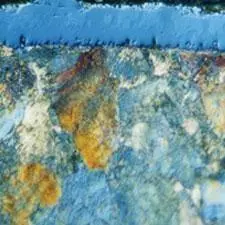
Material: WC-Co Powder Metal
Results: Regularly shaped WC particles can easily be seen in the microstructure of this cermet sample containing %80 - 97 WC (+TiC) and Co. Diamond grinding pads can also be used for grinding process. After etching, potasium permanganate solution helps to obtain attractive images.
Etching: Murakami
Cutting: SERVOCUT 302-AA Cut-off machine with ø250 Diamond cut-off wheels (600049)
Mounting: Ecopress 102 Automatic Mounting Press with Black Epoxy
Mechanical Preparation: FORCIPOL 102 grinding and polishing system.
| Parameter / Stage | Surface | Abrasive | Lubricant | Force per Sample, (N) | Time min. | Disc Speed, rpm | Relative Rotation |
|---|---|---|---|---|---|---|---|
| Planar Grinding | Diaflex (N) | 200 Grit | Water | 25 | 1 | 250 | Contra |
| Fine Grinding | Diamond grinding disc | 1200 Grit | Water | 25 | 2 | 300 | Contra |
| Pre Polishing | Fine grinding disc. Green | 3µ Aquapol-P Diamond Suspension | Blue | 15 | 4 | 150 | Contra |
| Final Polishing | MBL Polishing Pad | 1µ Aquapol-P Diamond Suspension | Blue | 15 | 1 | 150 | Contra |
Magnification: 800X
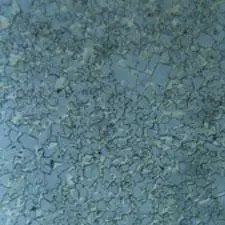
Material: White Cast Iron, alloyed
Results: The microstructure of high chromium white cast iron consists of alloy carbides (dark colour) and ledeburite. Hardness is around 600 kg/mm² and has high wear resistance. To prevent edge effects, epoxy type mounting material is recommended.
Etching: Vilella
Cutting: TRENO-H Aluminium Oxide cut off wheel.
Mounting: Ecopress 102 Automatic Mounting Press with Black-Epoxy (600811)
Mechanical Preparation: FORCIPOL 102 grinding and polishing system.
| Parameter / Stage | Surface | Abrasive | Lubricant | Force per Sample, (N) | Time min. | Disc Speed, rpm | Relative Rotation |
|---|---|---|---|---|---|---|---|
| Planar Grinding | Diamond Grinding Disc | 220 Grit | Water | 25 | Until Plain | 250 | Contra |
| Grinding | Diamond Grinding Disc | 600 Grit | Water | 25 | 2 | 250 | Contra |
| Fine Grinding | Diamond Grinding Disc | 1200 Grit | Water | 25 | 2 | 300 | Contra |
| Fine Grinding | Fine Grinding disc Green | 3µ Aquapol-P Diamond Suspension | Blue | 15 | 4 | 150 | Contra |
| Final Polishing | NLH | 1µ Aquapol-P Diamond Suspension | Blue | 15 | 1 | 150 | Contra |
Magnification: 100X
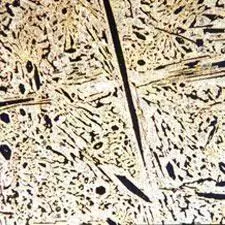
Material: Carbon Fibre
Results: This process has produced a scratch free polish on all the various carbon fibre samples.
Cutting: Sections approx 5mm x 20mm were cut from each type of carbon fibre using a Micracut 202. Cut off wheel used - 200mm high concentration diamond, with a wheel speed of 600rpm and Feed rate: 100µ/s.
Mounting: Cold Mounting - 25mm Teflon Moulds, Kemet KEPT Epoxy resin. Cure time is 10 hours at 25° C.
Mechanical Preparation: FORCIPOL 102 grinding and polishing system. 300mm Aluminium LOD.
| Parameter / Stage | Surface | Suspension | Lubricant | Platen Speed | Head Speed | Pressure | Time |
|---|---|---|---|---|---|---|---|
| Planar Grinding | 300mm 600G SiC Bramet | N/A | Water | 150 CCW | 80 | 25N | 120 sec |
| Grinding | 300mm 800G SiC Bramet | N/A | Water | 150 CCW | 80 | 25N | 120 sec |
| Fine Grinding | 300mm 1200G SiC Bramet | N/A | Water | 150 CCW | 100 | 25N | 120 sec |
| Fine Grinding | 300mm 2500G SiC Bramet | N/A | Water | 150 CCW | 100 | 25N | 120 sec |
| Final Polishing | 300mm ASFL-M Bramet | 1µ Aquapol-P Diamond Suspension | GW2 | 150 CCW | 80 | 25N | 120 sec |
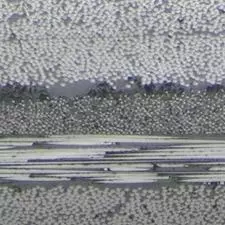
What is Metallographic Specimen Preparation?
Metallographic specimen preparation is the process of preparing samples of metallic materials for microscopic examination. The purpose of this process is to produce a flat, polished surface that is free of artifacts, scratches, and other deformations that can interfere with the analysis of the microstructure of the metal. The metallographic specimen preparation process involves several steps, including cutting, mounting, grinding, polishing, and etching. First, a small section of the metal is cut using a saw or a cutting tool. The cut surface is then mounted on a holder, which is typically made of a material that is easy to hold and will not react with the metal being examined.
After mounting, the specimen is ground and polished to produce a smooth, flat surface. This is typically done using a series of progressively finer abrasive materials, starting with coarse abrasives and ending with very fine abrasives. The final step is to etch the surface of the metal with a chemical solution that will reveal the microstructure of the metal. Metallographic specimen preparation is an important step in the analysis of metallic materials, as it allows researchers and engineers to study the microstructure of metals and identify any defects, inclusions, or other features that may affect the performance of the material. This information can then be used to improve the design and performance of metallic components in a wide range of applications, from aerospace to automotive engineering.